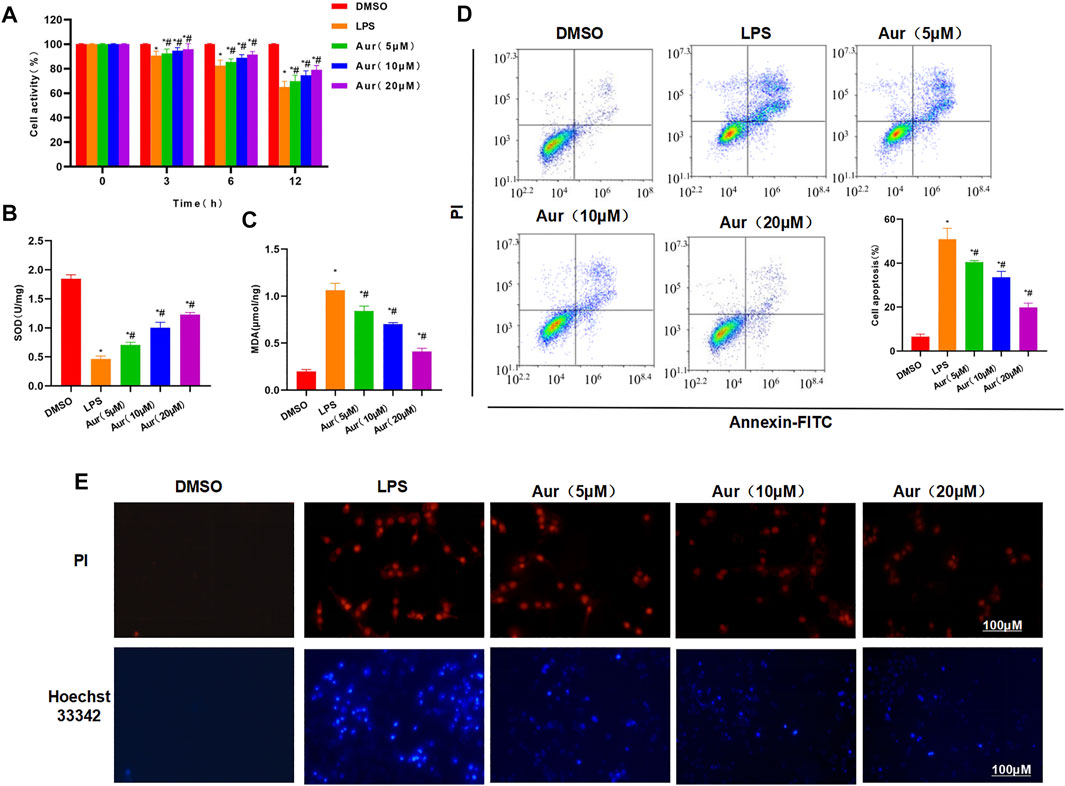
95% of researchers rate our articles as excellent or good
Learn more about the work of our research integrity team to safeguard the quality of each article we publish.
Find out more
CORRECTION article
Front. Pharmacol. , 06 December 2021
Sec. Inflammation Pharmacology
Volume 12 - 2021 | https://doi.org/10.3389/fphar.2021.802304
This article is part of the Research Topic Autophagy in Inflammation Related Diseases View all 9 articles
This article is a correction to:
The Mechanism of Aureusidin in Suppressing Inflammatory Response in Acute Liver Injury by Regulating MD2
A corrigendum on
The Mechanism of Aureusidin in Suppressing Inflammatory Response in Acute Liver Injury by Regulating MD2
by Yang, Y., Han, C., Sheng, Y., Wang, J., Zhou, X., Li, W., Guo, L., and Ruan, S. (2020). Front. Pharmacol. 11:570776. doi:10.3389/fphar.2020.570776
In the original article, there was a mistake in Figure 1E as published. We used wrong atypical images in the layout and did not mark the magnification. The corrected Figure 1 appears below.

FIGURE 1. Effect of Aur on LPS-induced KC injury. (A) Effect of Aur on cell viability (n = 3). The cell viability in the LPS group was significantly more decreased than the DMSO group; while Aur treatment could suppress the decrease in viability, which was significantly different from the LPS group. In addition, the pairwise comparison was also statistically significant. Comparison with DMSO, *p < 0.05; comparison with LPS group, #p < 0.05. (B,C) Effect of Aur on SOD and MDA (n = 3). The SOD level was downregulated and the MDA level was upregulated in the LPS group, which were significantly different from the DMSO group. Aur treatment could decrease the MDA level and increase the SOD level in a dose-dependent pattern. Comparison with DMSO, *p < 0.05; comparison with LPS group, #p < 0.05. (D) Apoptosis assay (n = 3). The apoptotic level was low in the DMSO group, LPS could significantly increase the apoptotic level, and Aur could downregulate the apoptotic level. Comparison with DMSO, *p < 0.05; comparison with LPS group, #p < 0.05. (E) PI staining and Hoechst 33342 staining (n = 3). Positive cells were barely detectable in the DMSO group, which were significantly upregulated in the LPS group. While the number of positive cells was downregulated in the Aur group, indicating the suppressed apoptosis.
The authors apologize for this error and state that this does not change the scientific conclusions of the article in any way. The original article has been updated.
All claims expressed in this article are solely those of the authors and do not necessarily represent those of their affiliated organizations, or those of the publisher, the editors and the reviewers. Any product that may be evaluated in this article, or claim that may be made by its manufacturer, is not guaranteed or endorsed by the publisher.
Keywords: aureusidinmyeloid, differentiation protein 2, acute liver injury, inflammatory response, lipopolysaccharide, toll likes receptor
Citation: Yang Y, Han C, Sheng Y, Wang J, Zhou X, Li W, Guo L and Ruan S (2021) Corrigendum: The Mechanism of Aureusidin in Suppressing Inflammatory Response in Acute Liver Injury by Regulating MD2. Front. Pharmacol. 12:802304. doi: 10.3389/fphar.2021.802304
Received: 26 October 2021; Accepted: 22 November 2021;
Published: 06 December 2021.
Edited and reviewed by:
Paola Patrignani, University of Studies G d’Annunzio Chieti and Pescara, ItalyCopyright © 2021 Yang, Han, Sheng, Wang, Zhou, Li, Guo and Ruan. This is an open-access article distributed under the terms of the Creative Commons Attribution License (CC BY). The use, distribution or reproduction in other forums is permitted, provided the original author(s) and the copyright owner(s) are credited and that the original publication in this journal is cited, in accordance with accepted academic practice. No use, distribution or reproduction is permitted which does not comply with these terms.
*Correspondence: Shuiliang Ruan, cnVhbmd1YW5AaG90bWFpbC5jb20uY24=
†These authors share first authorship
Disclaimer: All claims expressed in this article are solely those of the authors and do not necessarily represent those of their affiliated organizations, or those of the publisher, the editors and the reviewers. Any product that may be evaluated in this article or claim that may be made by its manufacturer is not guaranteed or endorsed by the publisher.
Research integrity at Frontiers

Learn more about the work of our research integrity team to safeguard the quality of each article we publish.